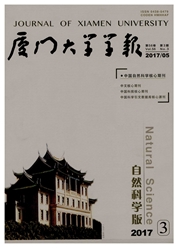

 中文摘要:
中文摘要:
选用TCA/丙酮沉淀法、缓冲液法、柱层析法、裂解液法和裂解液-超速离心法分别提取金乌贼视神经节蛋白质,其中蛋白质得率较高的方法有裂解液-超速离心法、裂解液法,其次为TCA/丙酮沉淀法.经双向凝胶电泳分离,并采用Melanie 4 Trial软件统计蛋白质斑点数目.发现pH5~8范围的载体两性电解质适合于分离视神经节蛋白质组,其电泳图谱中多数蛋白质斑点清晰可见,显示出高分辩率、重复性好和易取样供质谱分析的优点,适合于开展视神经节蛋白质组学研究.裂解液-超速离心法是金乌贼视神经节最佳蛋白质提取方法.
 英文摘要:
英文摘要:
Five analytical approaches, such as the precipitation separation of TCA/acetone, the buffer extraction,the column chromatography, the lyolysis buffer, and the lyolysis-ultracentrifugation,were compared to extract and separate the protein from the optic ganglion of Sepia esculenta,respectively. With the reference to total protein concentration,both the lyolysis buffer and the lyolysisultracentrifugation can obtain the maximum output of the protein,next with the precipitation separation of TCA/acetone. We indicated that the carrier amopholytes covering range of pH 5.0-8.0 is suit for separating the proteome of optic ganglion. Most protein spots in the gel were clearly observed, showing much advantage of high resolution,of perfect repetition, of taking protein spots easily for analysis of mass spectrometry after separated with 2-DE. Thus,we indicated it is suit for employing the proteomic research in the optic ganglion. The lyolysis-ultracentrifugation is a perfect approach for extracting protein in the optic ganglion of Sepia esculenta.
 同期刊论文项目
同期刊论文项目
 同项目期刊论文
同项目期刊论文
 期刊信息
期刊信息
